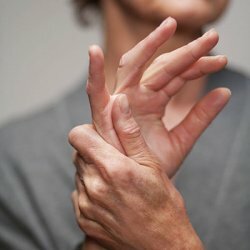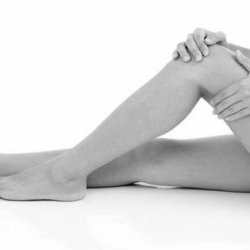Carpal tunnel syndrome( tunnel syndrome): symptoms and treatment

Tunnel syndrome( tunnel neuropathy) is a complex of symptoms that arise as a result of compression of peripheral nerves in narrow anatomical spaces - tunnels.The medical literature describes more than thirty variants of tunnel neuropathy.There are tunnel syndromes with lesions of the upper, lower extremities, neck, trunk.Carpal tunnel syndrome is the most widely spread, which is why this disease is often called tunnel syndrome.In the structure of tunnel neuropathies carpal tunnel syndrome accounts for 50% of all cases.
Table of Contents:Causes of Tunnel Wrist Syndrome
The carpal tunnel is located at the base of the wrist.It is formed by the carpal bones and the transverse ligament.Inside the canal there pass the median nerve, the flexor tendons of the fingers and the hand, and also their synovial membranes.
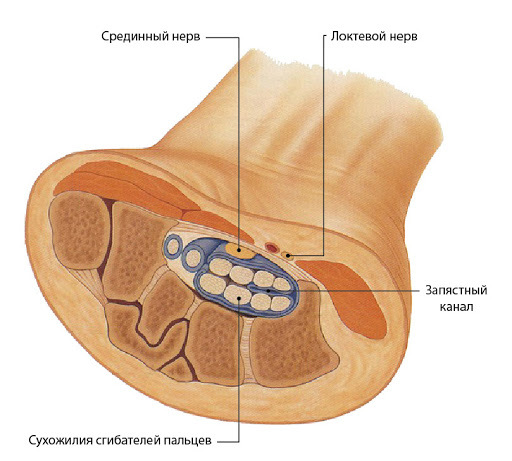
The median nerve consists of sensitive and nerve fibers.Sensitive fibers are responsible for the sensitive innervation of the skin of the palmar surface of the first three and half of the fourth finger, as well as the back surface of the nail phalanges of the same fingers.Motor fibers provide movement of the fingers of the hand.
Normally, the median nerve passes freely in the canal.But with microtraumatism of ligaments that arise in people of certain professions, thickening and edema of the transverse ligament develop, which leads to compression of the nerve.As a result of chronic inflammation of the connective tissue, which is caused by a constant uniform load, the ligament thickens, swelling, which leads to an increase in pressure within the canal.Elevated pressure leads to venous congestion and, as a result, impairment of blood supply to the nerve.
First of all, the sensitive fibers of the nerve, and then the motor fibers, suffer.In addition, fibers of the autonomic nervous system may be damaged.
Causes leading to carpal tunnel syndrome:
- Genetic predisposition( square wrist, thickened transverse ligament);
-
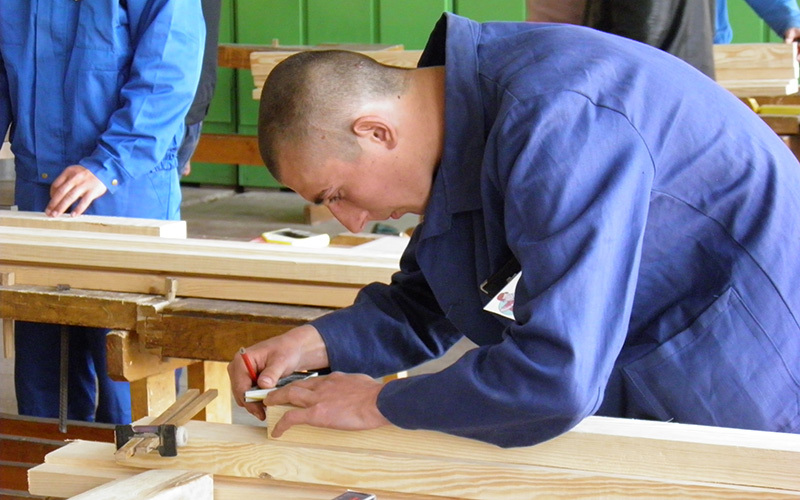 Professional activity associated with constant flexion-extension of the brush( typists, seamstresses, pianists, painters, collectors, carpenters, carvers, masons);
Professional activity associated with constant flexion-extension of the brush( typists, seamstresses, pianists, painters, collectors, carpenters, carvers, masons); - Prolonged work at the computer;
- Injuries( for example, with a fracture of the bones of the wrist);
- Pregnancy, lactation, menopause;
- Endocrine diseases( acromegaly, hypoparathyroidism);
- Admission of hormonal contraceptives;
- Renal failure;
- Joint damage( rheumatoid arthritis, gout);
- Subcooling.
The peak incidence falls on 40-60 years.It is noteworthy that women are sick more often than men.This is probably due to the fact that in women the carpal canal is narrower.
Symptoms of carpal tunnel syndrome
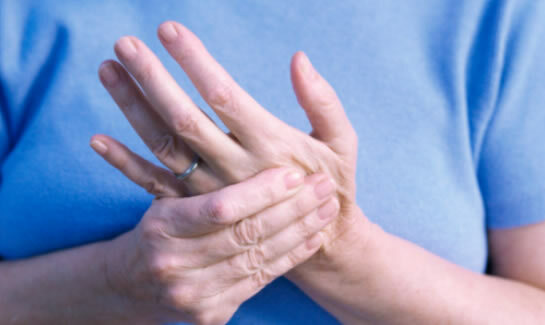 Approximately half of all cases involve both brushes.But it is worth noting that the signs of the disease primarily arise on the "working" hand( right-handed people on the right, left-handers on the left).
Approximately half of all cases involve both brushes.But it is worth noting that the signs of the disease primarily arise on the "working" hand( right-handed people on the right, left-handers on the left).
Carpal tunnel syndrome develops gradually.The first sign of ailment is the appearance of a feeling of pain and numbness in the first three fingers of the hand arising at night.These unpleasant symptoms prevent a person from sleeping normally.When a person wakes up, he is forced to lower his hand down, to brush off the brush.Then the pain passes, but by morning comes back.Pain is felt throughout the finger from its base to the terminal phalanx.
When the disease begins to progress, the pain begins to bother a person even in the daytime, which greatly affects its activity.It is noteworthy that any movement in the wrist strengthens the pain.
Another characteristic symptom is the numbness of the first three fingers in the morning.But then the person begins to feel numbness during the night and daytime.Unpleasant symptoms in the fingers are strengthened by prolonged holding the brush on the weight, for example, while talking on the phone or driving a car.
With the progression of the disease, there is a muscle weakness in the area of the hand.Thus, it is difficult for a person to hold small objects in his hand, they escape from the hands.At later stages, atrophy of the muscles of the hand develops, contractures in the form of the so-called "monkey's paw".
With a strong or prolonged compression of the median nerve, a decrease in sensitivity develops.The patient may not feel a touch or even painful irritation in the area of the first three fingers.
When the vessels are squeezed inside the canal, the skin of the wrist may turn pale, decrease in local temperature and swelling.

Diagnosis of carpal tunnel syndrome
Sometimes tunnel syndrome can be accompanied by pain not only in the hand, but also in the forearm, elbow.This confuses the doctor and can lead to the thought of another pathology, for example, osteochondrosis.Therefore, special methods are used to carry out differential diagnostics.
For example, there is a simple test of raised hands.The patient raises his straightened arms above his head and holds for a minute.In the case of carpal tunnel syndrome, the first three fingers experience numbness and tingling, sometimes even pain.
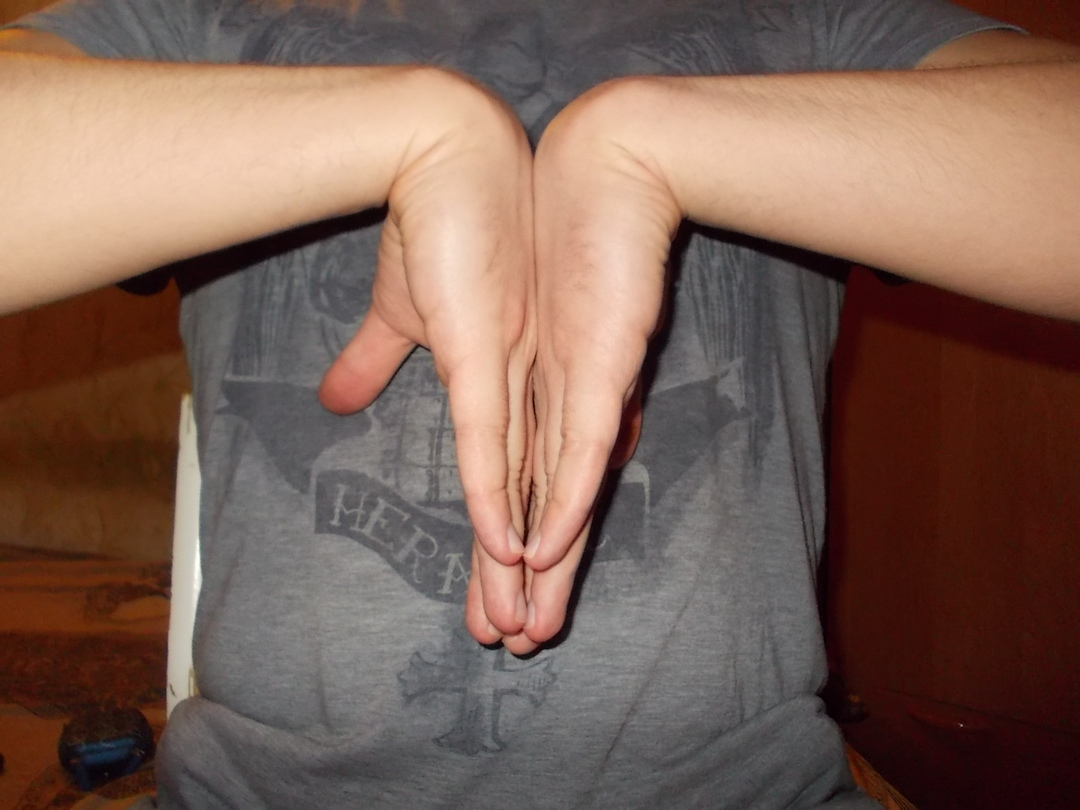 For a Falen test, the patient is asked to bend the brush and hold it for one minute.In the presence of carpal tunnel syndrome, the first three fingers increase tingling and pain.
For a Falen test, the patient is asked to bend the brush and hold it for one minute.In the presence of carpal tunnel syndrome, the first three fingers increase tingling and pain.
The cuff test is also sometimes performed.On the patient's arm, the doctor puts on the cuff to measure blood pressure.Then, it presses the cuff over 120 mmHg, which is held for a minute.In carpal tunnel syndrome, tingling occurs in the fingers innervated by the median nerve.
But the most reliable diagnostic method is still the Tinel test.The doctor taps a finger or a mallet over the median nerve.In the presence of carpal tunnel syndrome, tingling in the fingers occurs.
A useful diagnostic test is the administration of corticosteroids with lidocaine into the carpal tunnel.If after that the pain and tingling in the fingers decrease, then the pathological process is located in the carpal tunnel.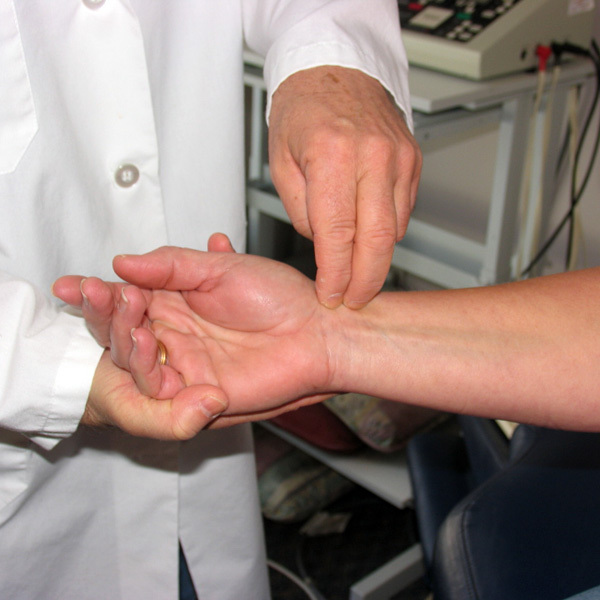
The leading instrumental method for determining carpal tunnel syndrome is electroneuromyography.With the help of this study, it is possible to measure the electrical activity of skeletal muscles, as well as the speed of carrying out a nerve impulse.In rest, the electrical activity of the muscles is minimal, and with muscle contraction increases.But in the presence of carpal tunnel syndrome during muscle contraction, electrical activity is low, as the nerve impulse over the damaged median nerve slows down.

Treatment of carpal tunnel syndrome
Treatment of carpal tunnel syndrome is primarily aimed at eliminating the cause of the disease, as well as to eliminate pain, improve local blood circulation, nutrition and innervation of tissues, restore the function of the hand.
Conservative treatment
Conservative treatment will be most effective in patients with symptoms observed for no more than a year. This includes the wearing of a supporting tire and the administration of such medicines:
-
 Non-steroidal anti-inflammatory drugs( diclofenac, movalis);
Non-steroidal anti-inflammatory drugs( diclofenac, movalis); - Corticosteroids( prednisolone, hydrocortisone);
- Vasodilators( nicotinic acid, trental);
- Diuretics( furosemide, veroshpiron);
- Muscle relaxants( sirdalud, midocalm);
- Group B vitamins( neurorubin, milgamma).
An effective method of treatment is the administration of corticosteroids inside the carpal tunnel.After the first such procedure, the patient feels considerable relief.
Criteria for predicting low efficacy of conservative treatment:
- Patient age greater than fifty years;
- Symptoms of the disease are observed for ten or more months;
- Constant tingling in the fingers of the hand;
- Presence of stenosing tendon synovitis of tendons;
- Positive test of Feleng in less than thirty seconds.
Thus, in 66% of patients without a single criterion, conservative treatment achieves a good result, in 40% - in the presence of one criterion, in 16.7% - with two and 6.8% - in the presence of three or moreCriteria.
Surgical treatment
With the progression of the disease and in the absence of a result from conservative therapy resort to surgical treatment.The operation should be performed prior to the onset of irreversible damage to the median nerve.Under the condition of a timely operation, it is possible to achieve a good result in 90% of patients.The purpose of surgery is to reduce pressure on the median nerve by expanding the intracanal lumen.The operation can be performed endoscopically or in an open manner.

After the operation, a plaster cast is applied to the brush for several days.In the recovery period, the patient is shown to perform therapeutic exercises with a fixed wrist and physiotherapy procedures.If the disease is caused by the peculiarities of the profession, you should change the type of activity for the recovery period.After three months, the brush functions are restored approximately by 70-80%, and after half a year completely.
After full recovery, a person can return to his occupation.But if unfavorable working conditions are not eliminated, recurrence can not be avoided.
Prevention of carpal tunnel syndrome
The incidence of carpal tunnel syndrome in recent years has increased significantly.This fact is associated with the fact that computers have appeared in human life.People at the computer work and spend their leisure time.With improper organization of the workplace, uncomfortable position of the brush during the use of technology, prerequisites are created for the development of carpal tunnel syndrome.
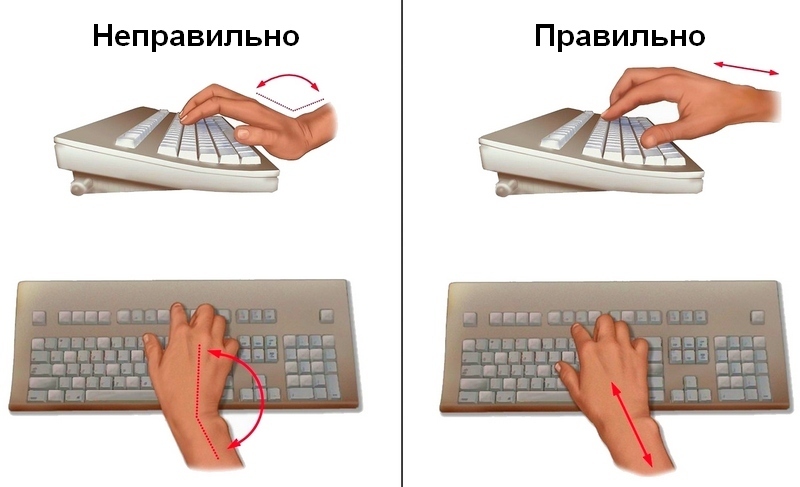
To prevent the onset of the disease, the following recommendations should be adhered to:
- Properly arrange your workplace.The table should not be too high.While working at the computer, the hand should not sag, but conveniently lie on the table or armrest of the chair.The brush should be straightened.
- Find the right keyboard and mouse.The mouse should fit comfortably in your palm.So the brush will be more relaxed.For people with carpal tunnel syndrome even a special mouse-joystick is created.Equally useful are special mouse rugs equipped with a roller at the wrist level.This will ensure the correct position of the brush.In addition, pay attention to the keyboard, located at an angle.
- Take breaks every thirty to forty minutes.
- Do exercises for the hands: shaking hands, rotational movements in the wrists, gripping the fingers into a fist and unclenching.
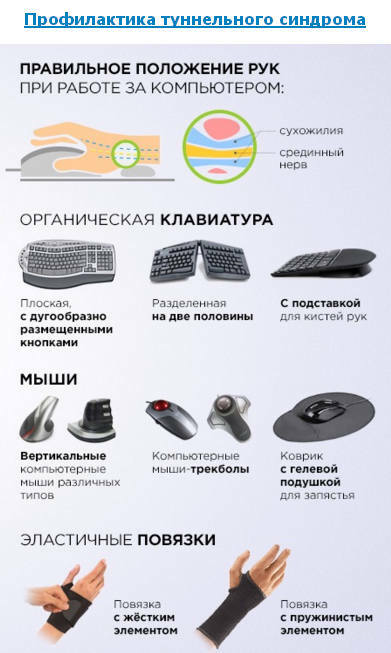
Grigorova Valeria, medical reviewer

